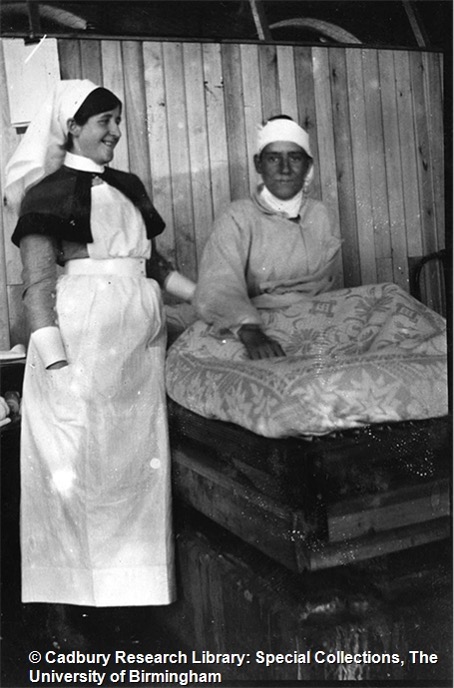At our February seminar, Sue Worrall, Director of Special Collections at UoB, presented her own research into the role of women working in the Territorial Force Nursing Service. In the post below, Justine Pick (doctoral candidate at UoB and MA West Midlands History) offers an overview….

Sue Worrall, as part of her doctoral research, is exploring the role of women working in the Territorial Force Nursing Service (TFNS) during the First World War at 1st Southern General Hospital, a military hospital housed in University of Birmingham buildings. Using sources from The National Archives and nurses’ personal papers held in Special Collections, the talk shed light on the women who served in the war, but whose identities and contribution have been relatively unexplored previously.
Sue began with offering context, at the time when nursing was in its infancy when there were competing views on the direction nursing should take and debates about professionalisation. A clear distinction was made in that that there were other also other army nursing services, in addition to the TFNS, during the war: the Queen Alexandra’s Imperial Military Nursing Service, the Queen Alexandra’s Imperial Military Nursing Service (Reserve), as well as the Voluntary Aid Detachment (VAD).
Sue went on to explain that the TFNS was established well before the war in 1908, as part of the reform of the British auxiliary forces introduced by Richard Haldane. Nurses with at least three years of training in hospitals were able to volunteer for the service, they had to be over 23 years old and unmarried or widowed. As part of these reforms, 23 large buildings were earmarked for use as hospitals in the event of war and this included the University of Birmingham. By 1911 about 3,000 nurses had volunteered, which meant continuing in their usual employment, but aware that they would be mobilised in the event of war.
At the outbreak of the war in August 1914, the military hospitals were established at the designated sites and the University of Birmingham became the 1st Southern General Hospital. By the end of that first month, just under 3000 nurses were mobilised to staff all the military hospitals, including some abroad. During the entire conflict a total of over 8,000 nurses served, with approximately 2,000 serving abroad. By 1917, the 1st Southern General had 8827 beds with overflow in tents in the grounds.
Shifting the focus to the nursing staff at the 1st Southern, Sue introduced some key sources that have helped build a more intimate picture of the nurses who served. Nurses’ military records are held at the National Archives and are now digitised. Although incomplete, Sue explained that this resource (which sadly is not sorted by hospital) can reveal quite a lot of valuable information. For instance, when and where they were born; training and their career to date; who their parents were; as well as medical records and details about their performance. They also reveal interesting appraisals as the example ‘Reports by Matron’ demonstrated.
Particular attention was made to matrons Miss E M Musson and Kathleen Lloyd and nurse Eveline Wauchope, due to personal papers held in Special Collections. These rich sources in combination with the military records, have assisted Sue in building a better picture of how the service operated, its hierarchy with uniforms and badges, as well as more personal aspects of individual nurse’s lives, their service, career and health and wellbeing. The stories of these women were brought to life with the use of contemporary photographs from the collections of the Cadbury Research Library and Birmingham Archives and Collections and offered a fascinating and rare insight into women’s war experiences.

my maternal grandmother i believe was based at this hospital during WW1. she was Lilian Moulson. how can i find out if there are any details of her please. i would dearly love to know anything about her.
You could try the archives at Birmingham City Council through their website or try the Birmingham Central library. Presumably the Cadbury Research Library at the University might be able to help too. Best of luck.
Hi Ann, also trying to find out more about my grandmother:)
Hello I have a photo of TFNS nurses during WW1 taken on the steps of the playing fields at Birmingham University. I would like to share it with you and possibly find out who some of the nurses are. Bye for now Dave Wichbold